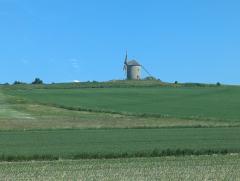 This was a more relaxing day, starting with a better appreciation of the Grand Hotel de Cabourg and then driving through the countryside of the Cotentin peninsula to Brittany, with famous Mont-Saint-Michel and then night in wonderful Saint-Malo.
This was a more relaxing day, starting with a better appreciation of the Grand Hotel de Cabourg and then driving through the countryside of the Cotentin peninsula to Brittany, with famous Mont-Saint-Michel and then night in wonderful Saint-Malo.
This is especially butter country. Normande cows, white with black or brown irregular speckles and splotches along their shoulders and sides, graze on the lush grass in this rural maritime area, subject to frequent fogs. The famous Normandy Beaches of WWII are on the eastern coast here. There was much fighting and ruins are common, but now all is peaceful the these cows produce rich milk used in making the celebrated Beurre d'Isigny.
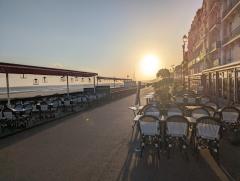 I had slept soundly after such a busy day, so got an early start, watching the sunrise. I explored more of the hotel and the waterfront area before the ladies woke up. It was quite cool and quiet. There's a great scene early in In the Shadow of Young Girls in Bloom in which our somewhat high-strung young hero steps out of the hotel onto the waterfront strip and is nearly run over by the first of four heedless teenage girls on roller skates. He is indignant, but as the summer proceeds he becomes fascinated with them, then infatuated with each in turn. As the next few summers unfold, he falls in love with each in turn, only to see the relationship fail for reasons more often than not caused by himself. It's some fine writing, and it all came back to me standing there in the quiet early morning light.
I had slept soundly after such a busy day, so got an early start, watching the sunrise. I explored more of the hotel and the waterfront area before the ladies woke up. It was quite cool and quiet. There's a great scene early in In the Shadow of Young Girls in Bloom in which our somewhat high-strung young hero steps out of the hotel onto the waterfront strip and is nearly run over by the first of four heedless teenage girls on roller skates. He is indignant, but as the summer proceeds he becomes fascinated with them, then infatuated with each in turn. As the next few summers unfold, he falls in love with each in turn, only to see the relationship fail for reasons more often than not caused by himself. It's some fine writing, and it all came back to me standing there in the quiet early morning light.
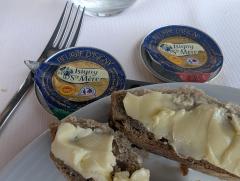 We had a very fine breakfast in the hotel, a huge buffet plus eggs to order, looking out across the beach to La Manche. I took advantage of the opportunity to compare and contrast the salted and sweet butters of Isigny-sur-Mer on fresh bread, as a sort of foreshadowing of the morning's adventure.
We had a very fine breakfast in the hotel, a huge buffet plus eggs to order, looking out across the beach to La Manche. I took advantage of the opportunity to compare and contrast the salted and sweet butters of Isigny-sur-Mer on fresh bread, as a sort of foreshadowing of the morning's adventure.
We finally loaded up the car for the drive to Isigny-sur-Mer, Mont St-Michel, and Saint-Malo - about four hours total driving time, with a goal to be in Saint-Malo by 4pm, with two hours for Mont-Saint-Michel.
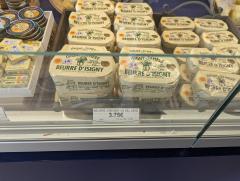 The town of Isigny-sur-Mer was interesting. It had a nice welcome center for the butter cooperative, where we bought some souvenirs and some of their "caramel" that was really more like a delicious semisoft fudge made with the local butter. Isigny-sur-Mer is near Normandy Beach, but we had little desire to see another scene of slaughter after our drive along the Somme's ghosts of WWI. There was a cluster of colorful houses along the river, but also a ton of cookie-cutter postwar housing and a maze of needlessly one-way streets. Isigny-sur-Mer had one serious problem: the on-ramp to the highway was closed and Google Maps didn’t know it - every alternative route took us up the same ramp. After wasting about half an hour, we finally escaped and had a delightful drive across Manche, the fifth of Normandy’s five districts.
The town of Isigny-sur-Mer was interesting. It had a nice welcome center for the butter cooperative, where we bought some souvenirs and some of their "caramel" that was really more like a delicious semisoft fudge made with the local butter. Isigny-sur-Mer is near Normandy Beach, but we had little desire to see another scene of slaughter after our drive along the Somme's ghosts of WWI. There was a cluster of colorful houses along the river, but also a ton of cookie-cutter postwar housing and a maze of needlessly one-way streets. Isigny-sur-Mer had one serious problem: the on-ramp to the highway was closed and Google Maps didn’t know it - every alternative route took us up the same ramp. After wasting about half an hour, we finally escaped and had a delightful drive across Manche, the fifth of Normandy’s five districts.
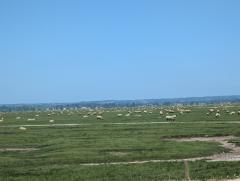 The drive across Manche was pleasant an uneventful. We saw plenty of pretty farmland and wooded countryside, and plenty of content Normande cows placidly munching on the plentiful grass.
The drive across Manche was pleasant an uneventful. We saw plenty of pretty farmland and wooded countryside, and plenty of content Normande cows placidly munching on the plentiful grass.
Eventually we turned south to the highway that leads across the top of Normandy an Brittany, and that would bring us to Mont Saint-Michel. This was everyday highway driving, but we really wanted to see the celebrated Mont Saint-Michel and still have time for shopping in the much larger Saint-Malo. As we approached the former, we saw the large flock of sheep owned by the monks of the abbey.
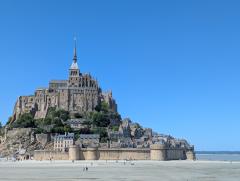 At high tide, Mont-Saint-Michel is an island, but the tide was out when we arrived. Nevertheless you have to park in a large public parking area and then either walk a long way or else take a shuttle bus. Some hardy pilgrims were walking the long trek from the parking area, but the shuttles run every 12 minutes and we had better uses for our time than meeting all those sheep, so we took the shuttle. From there it's a short walk to the ancient gate, beyond which is the tiny medieval city with lots of souvenir shops and ice cream parlors, and the famous restaurant of La Mere Poulard! That was my goal.
At high tide, Mont-Saint-Michel is an island, but the tide was out when we arrived. Nevertheless you have to park in a large public parking area and then either walk a long way or else take a shuttle bus. Some hardy pilgrims were walking the long trek from the parking area, but the shuttles run every 12 minutes and we had better uses for our time than meeting all those sheep, so we took the shuttle. From there it's a short walk to the ancient gate, beyond which is the tiny medieval city with lots of souvenir shops and ice cream parlors, and the famous restaurant of La Mere Poulard! That was my goal.
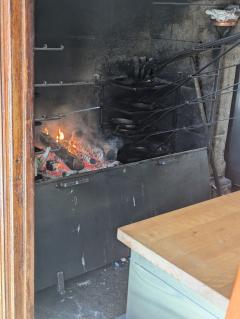 But my visit to La Mere Poulard failed! I was about 10 minutes too late, they had just closed. The fire in the oven was still burning, but they had stopped cooking their famous omelet and I had to settle for a nice cookbook from the restaurant at a nearby souvenir shop. Of course the cookbook did not have the secret recipe for the famous Omelette de la Mere Poulard, but that link goes to a pretty good version of it. I really wanted to see how it is served properly, and to maybe observe some tips of technique, so this was a major disappointment for me. I had no way of knowing that my double-dinner in Saint-Malo that evening would totally exorcise my disappointment of the afternoon!
But my visit to La Mere Poulard failed! I was about 10 minutes too late, they had just closed. The fire in the oven was still burning, but they had stopped cooking their famous omelet and I had to settle for a nice cookbook from the restaurant at a nearby souvenir shop. Of course the cookbook did not have the secret recipe for the famous Omelette de la Mere Poulard, but that link goes to a pretty good version of it. I really wanted to see how it is served properly, and to maybe observe some tips of technique, so this was a major disappointment for me. I had no way of knowing that my double-dinner in Saint-Malo that evening would totally exorcise my disappointment of the afternoon!
The bus is a pretty long drive from the common parking area - a quick visit took about 90 minutes from parking to departure. You could easily spend three hours without dining, and all day if you want to explore all the way up to the abbey.
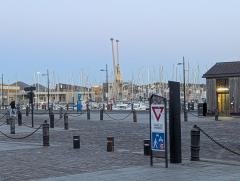 Upon leaving Mont-Saint-Michel, we made tracks to Saint-Malo for shopping, dining, more dining, and sleeping, in that order. Saint-Malo had been highly praised to me by my sister, a friend I went to school with, and another in my club. I had great expectations, and they were exceeded!
Upon leaving Mont-Saint-Michel, we made tracks to Saint-Malo for shopping, dining, more dining, and sleeping, in that order. Saint-Malo had been highly praised to me by my sister, a friend I went to school with, and another in my club. I had great expectations, and they were exceeded!
About those expectations: I'm not much of a shopper, except for books, and that would be silly in France. My interests are in history and local foodways and ingredients. Saint-Malo is a busy port city on the Channel - sorry! La Manche, and it lands much seafood, both shellfish and fin-fish. That was my target for our one night here, and I was anxious about another failure like that from the puffy omelet that I didn't get to try.
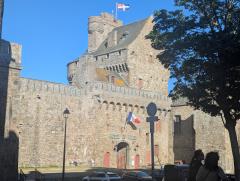 As we were driving in, Google Maps calmly explained to me that I would be performing a sort of brain-salad surgery to get Lorna and Melissa into the traffic-limited shopping area while the shops were still open, and then to proceed through the medieval streets to the Hôtel France et Chateaubriand. That was an adventure! It took about half an hour, through some places where a normal person would not take a rental car, down the wrong way on one of the many one-way streets and finally down a one-way slop of no return into a public parking lot behind the hotel, with a single parking space remaining. There was a young woman trying to figure out the parking kiosk rules, I left her to her own devices and risked the ticket to get to the hotel front desk.
As we were driving in, Google Maps calmly explained to me that I would be performing a sort of brain-salad surgery to get Lorna and Melissa into the traffic-limited shopping area while the shops were still open, and then to proceed through the medieval streets to the Hôtel France et Chateaubriand. That was an adventure! It took about half an hour, through some places where a normal person would not take a rental car, down the wrong way on one of the many one-way streets and finally down a one-way slop of no return into a public parking lot behind the hotel, with a single parking space remaining. There was a young woman trying to figure out the parking kiosk rules, I left her to her own devices and risked the ticket to get to the hotel front desk.
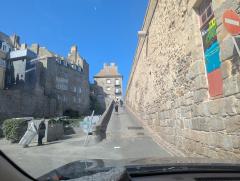 Naturally the entrance to the hotel was on the other side of the building, and bringing all of our luggage around to the front and into the depths of the building would have been trying. Fortunately the front desk clerk was able to hijack a luggage cart from another guest who "didn't need it for 20 minutes" and the we hustled out through the back door of the busy kitchen right into the parking lot. We loaded up the cart and then took it four-wheeling up the curb and through the busy kitchen, down a few halls I never saw again, and to the elevator. Then we rushed to the desk and he got me checked in so he would know where to send me...by the time I had everything in the room I was ready to be embalmed.
Naturally the entrance to the hotel was on the other side of the building, and bringing all of our luggage around to the front and into the depths of the building would have been trying. Fortunately the front desk clerk was able to hijack a luggage cart from another guest who "didn't need it for 20 minutes" and the we hustled out through the back door of the busy kitchen right into the parking lot. We loaded up the cart and then took it four-wheeling up the curb and through the busy kitchen, down a few halls I never saw again, and to the elevator. Then we rushed to the desk and he got me checked in so he would know where to send me...by the time I had everything in the room I was ready to be embalmed.
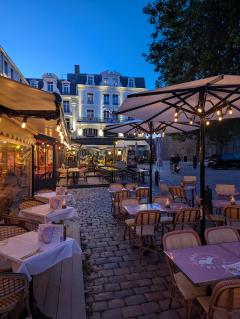 The hotel was in a good location, with plenty of good restaurants nearby and walking distance to the shopping district. It is a very pretty area, with no cars.
The hotel was in a good location, with plenty of good restaurants nearby and walking distance to the shopping district. It is a very pretty area, with no cars.
In France and Italy, they are much more protective of the human experience: there are more pedestrian-only areas with specific exemptions for delivery vehicles during limited times (usually in the morning), and for taxis. The best hotels are often in these areas, so usually you can get a pass from your hotel to enter a restricted area to check in and check out, that sort of thing. There are cameras that record your license plate and they will send you a ticket by certified mail if your license plate was not registered by your hotel.
They make it easy enough for tourists, and your outdoor dining experience is not ruined by a loud motorcycle or the exhaust from an idling truck. It also means that they walk more, get more exercise, and see each other smiling on a summer evening rather than scowling behind the windshield.
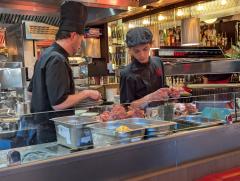 Melissa had snacked during the afternoon and had some work to catch up on. With our vegetarian absent, Lorna and I were free to find a seafood restaurant. We did, and I had a totally fabulous once-in-a-lifetime dinner at Cafe L’Ouest!
Melissa had snacked during the afternoon and had some work to catch up on. With our vegetarian absent, Lorna and I were free to find a seafood restaurant. We did, and I had a totally fabulous once-in-a-lifetime dinner at Cafe L’Ouest!
We sat right next to the open kitchen, with me facing it so I could see what was going on. That was fun, but it also turned out to be educational, as you will see in a moment.
Here's my extravagant tour of Breton seafood excellence:
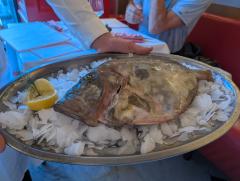 We started with an amuse-bouche of a fresh tuna pate.
We started with an amuse-bouche of a fresh tuna pate.- The catch of the day was John Dory, that the Italians call San Pietro, and that I have many recipes for but have never seen in the US. It's a white fish with a sweet delicate flavor between cod and haddock and in some ways superior to both. I got the whole fish! They brought it to me to see before cooking so I could be satisfied of its freshness; Lorna was non-plussed.
- Lorna had the Sole Meuniere, which she declared as good as the one she'd had the previous evening in Cabourg (it seemed like a week ago!).
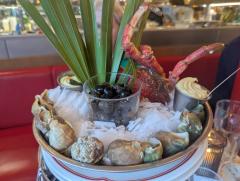 While Lorna had dessert, I got my own style of "dessert": bulot, bigorneaux, and coques (whelks, winkles, and cockles). The cockles were served hot with butter, garlic, and parsley, but the first two were served with homemade mayonnaise on an elaborate tray of ice watched over by the empty shell of a spider crab!
While Lorna had dessert, I got my own style of "dessert": bulot, bigorneaux, and coques (whelks, winkles, and cockles). The cockles were served hot with butter, garlic, and parsley, but the first two were served with homemade mayonnaise on an elaborate tray of ice watched over by the empty shell of a spider crab!- As the server described to me the different preparations, a helpful cook working right behind Lorna held up examples for me to see! He's the young fellow on the right in the photo above.
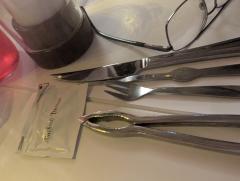 The whelks and the winkles were in their shells, so I was given an assortment of picks with which to extract them, a skill that I quickly mastered. The winkles are small, so they weren't so difficult, but the whelks required more skill. It's all in the wrist, and in observing the direction of the twist of the shell. The meat is inside the shell, following the twist. If you try to pull it straight out, it will break off where it "goes around the bend" and you won't be able to reach the rest. So you reach the pick as far in as you can, and just twist it out in the same direction as the shell twists. Voila! You get the whole piece.
The whelks and the winkles were in their shells, so I was given an assortment of picks with which to extract them, a skill that I quickly mastered. The winkles are small, so they weren't so difficult, but the whelks required more skill. It's all in the wrist, and in observing the direction of the twist of the shell. The meat is inside the shell, following the twist. If you try to pull it straight out, it will break off where it "goes around the bend" and you won't be able to reach the rest. So you reach the pick as far in as you can, and just twist it out in the same direction as the shell twists. Voila! You get the whole piece.
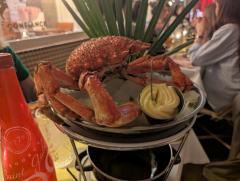 By the time I reached the end of this gustatory epic, I had but one regret: long-time readers may recall my multi-year quest to find the Venetian Granseola spider crab appetizer, and the shells in which it is traditionally served. Finally during last year's expedition to Venice I succeeded in bringing home a single shell, which is now framed and hanging in our dining room in Plymouth.
By the time I reached the end of this gustatory epic, I had but one regret: long-time readers may recall my multi-year quest to find the Venetian Granseola spider crab appetizer, and the shells in which it is traditionally served. Finally during last year's expedition to Venice I succeeded in bringing home a single shell, which is now framed and hanging in our dining room in Plymouth.
Now here in Saint-Malo I could see a bushel-basket of spider crabs, and the young fellow in the kitchen was ripping through them at high speed and sending them out to tables. Just as I paid the check, Melissa finished her work and joined us. We all sat down and they got crepes; naturally I got the spider crab for a second dessert!
Scoreboard: In one epic meal I got to try these new Breton classics: John Dory, cockles, whelks, winkles, and spider crab.
